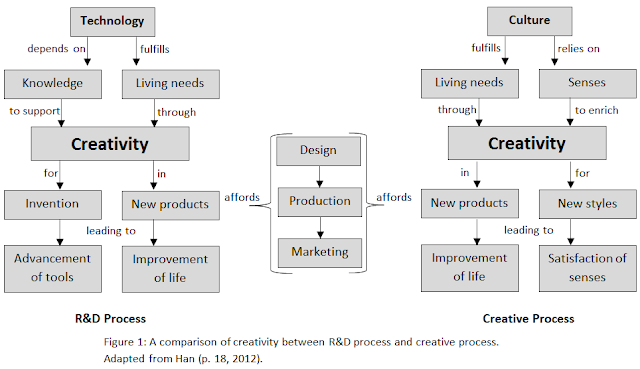I have read Han’s (2012) Design Thinking. I found is
meaningful for the context in Malaysia. Thus I translated some of the texts for
my teaching and sharing purposes.
Technology creativity
|
Cultural creativity
|
Aims to improve the quality
of living through the enhancement of the performance of products.
|
Aims to improve the quality
of living through the enhancement of spiritual fulfillment.
|
Grounded on technology.
|
Grounded on feeling.
|
Need knowledge as the
basis, hence the notion of knowledge economy.
|
Need pleasure feeling as
the basis.
|
The field of technology
requires continuous innovation through in-depth R&D of knowledge.
|
Cultural innovation occurs
through imagination.
|
Reply on relatively young PhD
holders who are graduated from world leading universities to lead high-tech
industry. Those who reach the age of 40 might have lost their innovative
capability in R&D, thus they have to move into managerial positions.
|
Rely on heart-touching new
styles to lead the creative industry, which might be started who one reaches
the age of 40.
|
Intellectual property (IP)
is the substance (本体) of civilization
|
Cultural creative industry
is the appearance (外衣) of civilization
|
Need to go through vertical,
inferential design thinking process within the profession, i.e. a R&D
process.
|
Not limited to a specific
boundary or profession, but requires a complete design process to integrate
multiple resources, in order to achieve the purpose of commercialization. The
commercialization process is alien to literati.
|
In the minds of agencies which manage culture-related
affairs, particularly when they think about nurturing cultural creative
industry, the prime focus is creative talents, i.e. those literati who are creative
and innovative. Therefore the agencies thought this could be achieved by organizing
some training courses or by inviting several world-renown speakers to talk
about creative industry. These efforts are merely depleting budget and yet
failing to nurture true creative talents, thus leaving the problem of
revitalizing cultural creative industry unsolved. This is due to the fact that
the actual dilemma is the absence of a creative environment; while the barrier
to having the creative environment is a general lack of design thinking
capability and habits in the society.
For example, in recent years, for the sake of enhancing the
quality of architecture, public and private sectors are keen to hire foreign renowned
architects to design, mainly through organizing international competitions. Does
it mean there is no creativity in the field of Taiwanese architecture? Of
course, judging from the existing buildings in Taiwan, there is hardly any
recommended designed by Taiwan masterpiece, but is this solely caused by the
tack of architectural skills or talents? No. We all know that the performance
of architecture standards can only be achieved through mutual cooperation
between architects and property owners. What are the owners? They are the
combination of the socio-cultural environment. If there is no vision that can
uncover architectural talents in this society; if there is no tolerance that
can indulge architects to show off their creativity; if there is no sufficient
resources to support architects, we should not blame Taiwan for not having
creative talents. In contrast, the required vision, tolerance and resources
have been allocated to satisfy the sense of worshiping foreign renowned masters—how
would such attitude establish the competitiveness of cultural creative industry
in Taiwan?
Therefore for the future of creative industry, we must first
recognize and comprehend the barriers in our cultural environment, particularly
those irrational factors, in order to identify the thinking method that can
generalize all requirements for development. If everyone in the country is
geared towards enhancing the attainment of the sense of aesthetics, while
recognizing the importance of systematic thinking, then we can truly move
forward to a highly developed society, where everybody takes the initiative to
be a sensible person.
